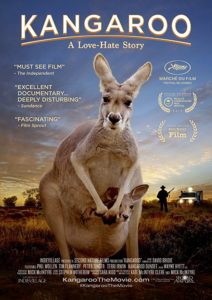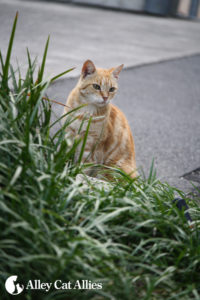
Mick McIntyre and Kate McIntyre Clere’s film, Kangaroos: A Love Hate Story, exposes Australia’s secret of killing kangaroos.
Who would’ve guessed thousands of kangaroos are slaughtered every night in their native Australia? After watching Kangaroo: A Love Hate Story, I felt I should have known. I wondered why I didn’t.
Then I realized I wasn’t supposed to know. Killing these marsupials is done in the dark, covertly, and far away from public scrutiny. It’s a dirty secret that filmmakers Mick McIntyre and Kate McIntyre Clere have just exposed in theaters across the United States. The film opens in Australia on March 13th.
What makes this movie intriguing and heartbreaking for me is that the plight of kangaroos and cats are so similar. The kangaroo is Australia’s national icon; the cat is one of our most beloved companion animals. Yet both are the targets of government-sanctioned killing that officials claim will improve the environment, though no scientific proof of this exists.
This mass slaughter is made possible because kangaroos, like cats, are the victims of a political campaign to justify their killing. Some farmers and ranchers, and their backers in government, call kangaroos “pests” and “vermin,” who exist in “plague proportions” and ruin the environment. Some anti-cat groups similarly call for all cats found outside to be rounded up and killed.
When groups of animals are vilified and maligned, they become scapegoats for a nation’s problems. Rather than take on the hard work of addressing the environmental damage that we cause to the planet — human-created issues such as climate change, habitat loss, pollution, deforestation, mining, and toxic chemicals — it’s far easier to blame certain species. No pun intended, but this is a kangaroo court.
Killing kangaroos and cats will not solve our environmental problems because they are not the cause of our environmental problems.
But that’s not something you’d ever know from reading the government-funded, industry-led collaboration, Counting the Cost: Impact of Invasive Animals in Australia, a report published by Australia’s Cooperative Research Centre for Pest Animal Control in 2004. This report, which only focuses on feral animals, including cats, claims that non-native species cost the Australian economy more than $720 million every year by preying on native animals. However, there’s no data in the report to support its claim against cats. But who cares? The words “feral,” “predation,” and “$720 million” are enough to create a mantra that non-native animals are bad and native animals are good. And that opens the door for governments to sanction the poisoning and shooting of cats.
Not only is all that cat killing wrong, it will not help endangered native species recover. But there’s another issue here: The notion that “non-native species” are of lower value that native species is an arbitrary distinction that, increasingly, conservationists are abandoning. Sadly, the Australian government’s views haven’t yet caught up with this.
But wait! There seems to be a glitch in Australia’s policy. It favors native species over non-native species, except when it doesn’t.
Kangaroos are native Australians. And sheep and cows aren’t. So why are Australia’s iconic species being exterminated? Because the Australian cattle and sheep industry supposedly injects more than $16.95 billion into the nation’s economy each year and employs more than 200,000 people. If ranchers say kangaroos are ruining crops and competing with their livestock for grazing land, who will argue?
There are some, like Dror Ben-Ami, PhD, a zoologist out of the University of Tel Aviv, who tells us that, after 30 years of research, there’s little evidence kangaroos are competing with ranchers for grazing land or harming the environment.
Here’s the real reason the killing exists: Greed. The kangaroo meat and skin industry reportedly generates $133 million a year in revenue. Who would have thought that kangaroo skin is used to make soccer shoes? Clearly, killing kangaroos is profitable for some. But there is also another excuse they use to justify the killing. The Australian government hopes that by removing its iconic species, it will be perceived as a champion of the environment. Meanwhile, it’s allowing its most habitat-destroying industries — animal agriculture, mining, and forestry — to continue to wreak havoc.
To put a favorable spin on killing kangaroos and their joeys, the Australian government released a document called “Improving the humaneness of commercial kangaroo harvesting.” It’s an attempt to convince the public no kangaroo offspring are hurt when killed. Similar claims are made about how cats are killed “humanely.” Yet, when we learn how kangaroos are killed, when we hear professional shooters say regulations and rules aren’t being followed, we know this: The killing of kangaroos and cats — is anything but humane.
That’s why films like Kangaroo: A Love Hate Story are so important. They expose cruelty and greed. It is up to us, however, to take action. We can choose not to buy products made from kangaroo or any animal. We can tell our politicians we don’t want our tax dollars spent on killing campaigns. And we can film, blog, tweet, and post about animal cruelty where and when we see it. Because one thing Kangaroo: A Love Hate Story has shown us, it’s that cruelty can’t stand the spotlight.


